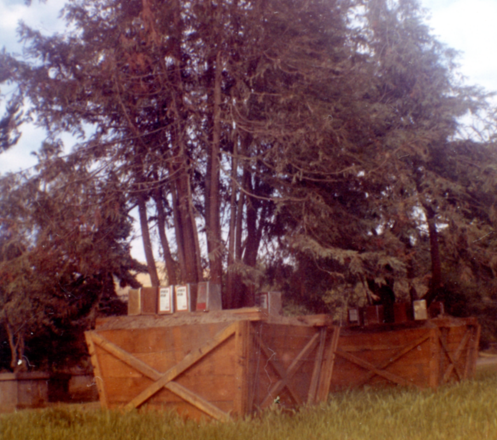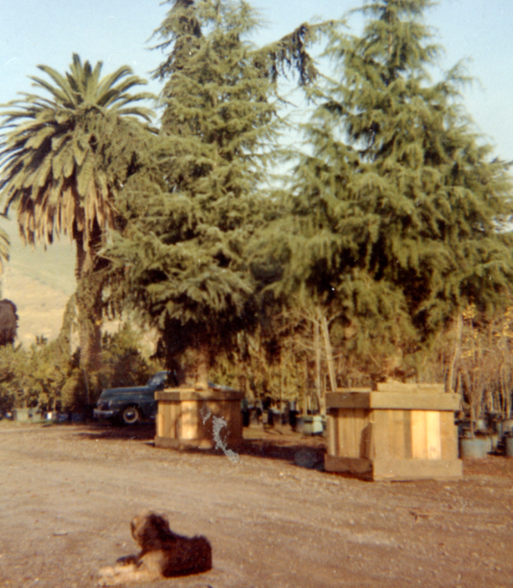|
California Nursery Historical Park
The Boxed Oak Forest
Coast Live Oak trees were once abundant in the San Francisco Bay
area as a native tree. California Nursery of Niles in Fremont not
only grew these large trees but sold them. Today, California
Nursery Historical Park contains an area of large 100-year-old
oaks in large boxes. These trees are a testament to the effort put
forth in keeping the nursery’s business thriving.
 |
 |
| boxing trees is a common
practice to tranport larege trees |
most trees can be boxed as long as as you save the
root ball |
In the 1950s and late 1960s, California Nursery endured financial
difficulties. The company went through a series of
bankruptcies.
Debt seemed impossible to pay off. The market continued to
change and developers made offers for the nursery land to be
purchased and converted into residential homes. George Roeding Jr.
took out a loan from the Lloyd Berry Foundation due to these
hardships. Lloyd Berry was a fellow Rotarian of George Roeding Jr.
who held a charitable
trust making money through selling fertilizer. As the loan’s
maturity date neared, George Roeding Jr. attempted to find a
resolution, starting with the large oak trees that were already on
the property.
California Nursery was known on the West Coast for its large oak
trees. On Block 9 of the nursery land stood several oak trees
roughly twenty years old. George Roeding Jr. moved these trees
closer to the nursery’s retail area to encourage clients to
purchase them. The oak trees were only boxed once officially sold,
however, George thought it would entice buyers to have them ready
to go. California Nursery workers would begin digging from the
side of the tree to create space for the tree to be removed.
Boxing trees that were originally in the ground could take up to
one year. Once boxed, the trees would then be carried off in
trucks.
Various types of trees were
boxed, from coast live oaks to cedars, redwoods, and even pine
trees. Placing the boxed oak trees closer to the retail area made
a positive impact. Clients grew interested in the various trees.
Those who purchased any spent about $1,500 to $2,000 per tree.
Despite the financial benefit of the live oaks, California Nursery
was still unable to fully pay back its loan to the Berry
Foundation. The nursery’s properties outside of Niles were lost to
fulfill remaining loan obligations. Berry passed on the
unfulfilled loan note to the Singer Housing Corporation. In 1971,
Singer Corporation foreclosed under CEO Jack Brooke, who acquired
the remaining 60 acres of the nursery property.
Singer Corporation
planned to build a housing division on the nursery land, however
they needed to secure a permit from the City of Fremont. The City
required that they issue acreage for a public park in their plans,
as each city was required to have a ratio of parks to residence.
Twenty out of the sixty acres of land was put aside for parks and
transferred to the City of Fremont. The twenty acres of nursery
land is now California Nursery Historical Park.
To this day, the boxed oak forest remains in its original area. The
surviving oak trees were boxed by the Roeding family to make space
for the neighborhood construction. These original boxes ultimately
withered away and the trees grew into the ground once again. The
City of Fremont made park repairs in the late 1990s, including
creating new boxes for the trees. Local volunteer Jill Singleton
honored the original box designs and created a new plan. City
employee of building maintenance Bill Marshall rebuilt all of the
boxes and had them installed for the trees in 2002. From here,
Fremont’s Naka Nursery rented the nursery land from the City of
Fremont. They maintained all of the park’s plants and trees.
However, after their closure in 2009, maintenance grew scarce.
Over half of the historic trees died due to a lack of water.
Thankfully, in 2011 non-profit organization Math Science Nucleus
(MSN) volunteered to preserve the remaining trees. New soil was
placed inside of the boxed trees. MSN worked alongside Richard
Valle, the Union City President of Tri-City Economic Development
Corporation (Tri-CED) Community Recycling, who worked with one of
the local community colleges to employ youth volunteers. Twenty
young men learned how to irrigate, dig trenches, compost, and a
variety of other green skills necessary in working together in
conserving the park.
Today, the boxed oak trees remain in the same area. Unfortunately,
only the native Coast Live Oaks remain. The City of Fremont staff
and council must work together to ensure that the park does not
perish. Both funds and focus on maintenance are required to
preserve the California Nursery’s property and history. With the
help of local volunteers within the community, the trees remaining
and the land itself can be properly nourished and cared for.
Contribution by: Joyce Blueford, Charlene Dixon
(TriCity Voice)
|